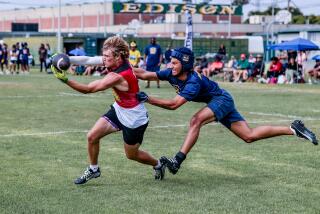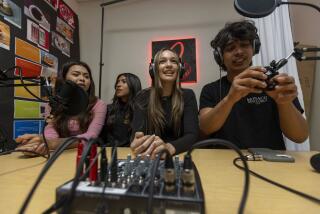BOYLE HEIGHTS : Role Models Learn Through Teaching
The third-graders at the Dolores Mission Elementary School can hardly contain their after-lunch energy as they jump into beanbags and type out paragraphs of their life in the reading lab.
Downstairs, Chris Evans’ second-graders are dipping their hands, some all the way up to their elbows, in a goo to paste strips of newspaper over blown-up balloons. The hardened shells will be cut in half to make masks for Dia de los Muertos.
In each class is a daily helper, a senior from Salesian High School who plays kickball, reads what the students write, puts up the chairs at the end of the day and performs other tasks.
“They play handball with us most of the time,” said Selina Pina, 8. “They’re nice.” The eight students, all hand-picked by Dolores Mission School Principal Michael Marasco, are following a legacy created by Marasco after his godson, Rene Vasquez, was killed at Estrada Courts last October.
At a Mass in March to celebrate Vasquez’s birthday, Marasco talked with one of his godson’s friends, Joel Villalpando Jr., who had been kicked out of Salesian and other high schools and “was notorious in this neighborhood for getting into all the trouble you can get into,” Marasco said.
After Vasquez’s death, Villalpando’s downward spiral accelerated. So Marasco, a former Salesian teacher, brought him to the school to help out in the classrooms.
“He started to really respond to the kids and they loved him,” Marasco said. “I tried to expand it and incorporate it into a role model program. I think it is a success that (teachers) saw this individual and how he responded. They said, ‘I can’t believe that’s him.’ ”
Now Villalpando works in the school’s Writing to Read lab where students learn word sounds, spelling and composition. He sees some who remind him of himself growing up, starting trouble and clowning around in class.
“It’s made me see things in a different way and think differently,” Villalpando said. “I see now how beautiful it is growing up and it’s neat when you can teach them something.”
Second-grade helper Ralph Rios has just received his birthday present from the students, a book of drawings of him playing football or with his family or in the classroom. Almost every caption reads, “You are my friend, Ralph.”
Rios said he wants to become a teacher and considers his work at the school “practice.” He has started an experiment with radish seeds so the students can watch them grow.
On the asphalt playground, Sal Magana pitched a ball to the first-grade boys playing kickball, then brought them inside to put things away and get ready to end the day.
Dennis Morales, with a cardboard mask held to his face, asked Magana to fasten the tie.
“I can’t see,” Dennis said, and Magana, laughing, pulled down the mask until the eye holes were positioned just right.
“I brought up my little cousins so I’m used to kids,” Magana said.
Most of the children shrugged when asked about their helpers. But teachers said the students are crazy about the high school seniors.
The classes break into cheers when the older boys walk into their designated classrooms. And the young girls had to be told to stop writing them love notes.
“They get really attached,” said Sister Marion Mills, who teaches first grade.
“He handles them very well,” Mills says of Magana. “I think it’s good for these boys because their fathers aren’t always around.”
Villalpando reflected on the effect he and the others may have on the students: “Mr. Marasco says that most of the kids my age around here don’t give the kids a good role model, but there’s some that do. I want to go to college, start a business and have a big nightclub. I don’t see (teaching) as a career, but I like the kids. They make me laugh.”
More to Read
Sign up for Essential California
The most important California stories and recommendations in your inbox every morning.
You may occasionally receive promotional content from the Los Angeles Times.










